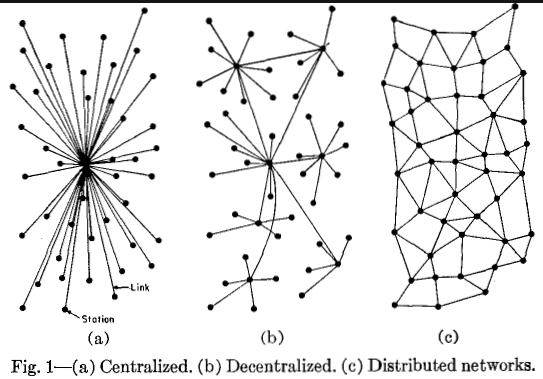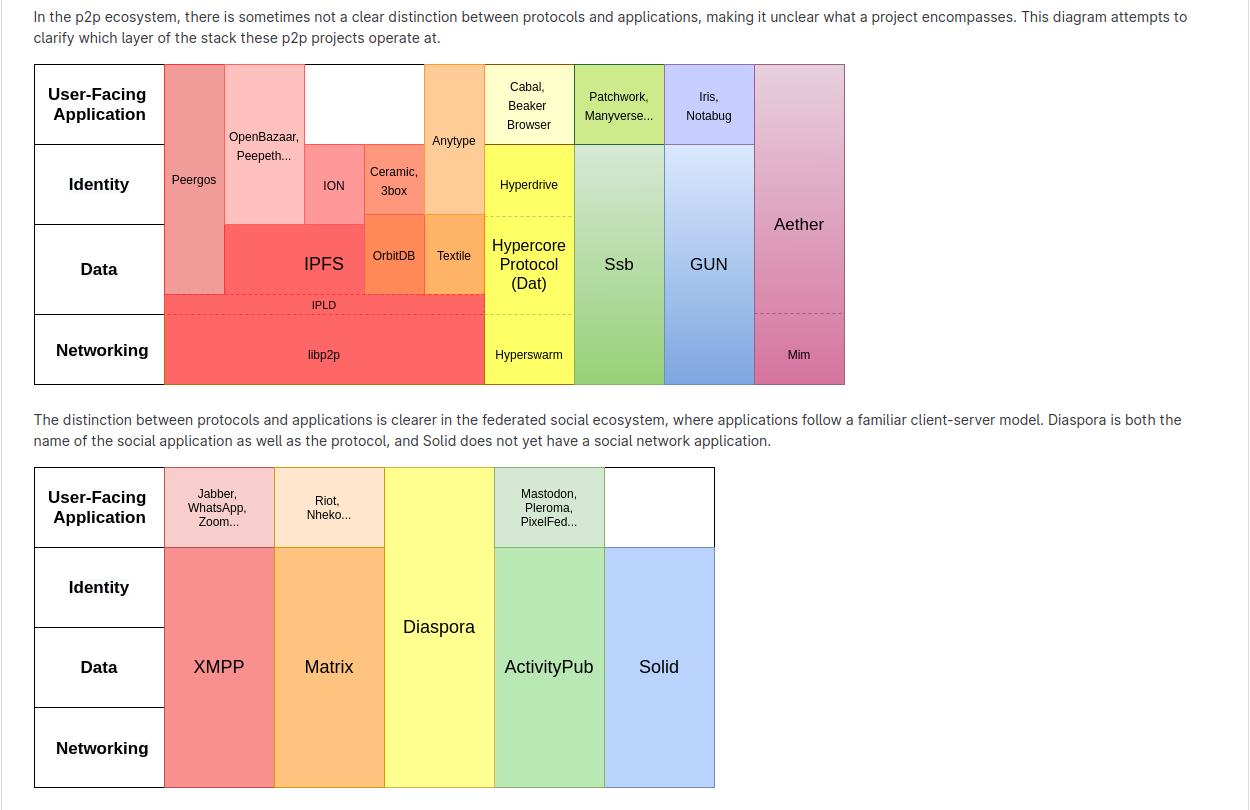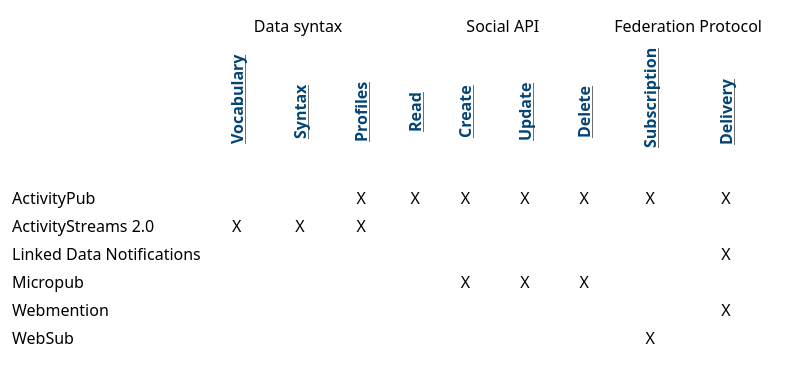tags : peer-to-peer, Archival, NAT, Internet, File Sharing, Human Computer Interaction ( HCI )
Structure


- Calling a network “decentralized” only defines it by what it is not
- It is not dependent on a single set of servers run by one company.
- What it actually is can look like many different things.
- Centralized and Distributed are easy to understand, Decentralized is a mess but here’s what I feel about it. I won’t even mention blockchain. The lines are very blurry and things keep changing.
- In the wild software use mix of centralized, distributed and decentralized so it’s hard to truly fit an application into these structure.
- The applications that can be made out of these structure is simply your imagination, filesharing, social networks, chat systems, hosting, identity systems and everything else.
Decentralized
- The Meaning of Decentralization. “Decentralization” is one of the words… | by Vitalik Buterin | Medium
- Centralization, Decentralization, and Internet Standards | Hacker News
- These systems usually have common things to deal with
- Identity
- Key management
- Moderation
- Monetization
- Decentralization: “For the builders, it’s a core feature. But for almost all users, it’s certainly a detail.”
P2P
- No distinction between clients and servers.
- Every user’s device can act as both, making them functionally equivalent as peers.
- Some nodes may have special roles, like public bootstrap nodes that help new users get connected to the network etc.
- See peer-to-peer
Federated
- Users are still interacting with a server
- But anyone can run a server that interoperates with others servers in the network, giving users more providers to choose from.
- This gives users more choices for applications, policies, and community cultures.
- See Federated systems
Hybrid
-
Like I said line is heckin blurry.
-
This is what nostr(a growing decentralized social network), mentions in its readme. It’s funny.
-
Nostr is not federated(A relay doesn’t talk to another relay, only directly to users), doesn’t work on p2p principles, still decentralized.
It doesn’t rely on any trusted central server, hence it is resilient; it is based on cryptographic keys and signatures, so it is tamperproof; it does not rely on P2P techniques, and therefore it works.
Things on the internet that make the internet


- See this: alternative-internet-dump
- See: Ecosystem Overview
- This is obviously not exhaustive.
- These things are complimentary to other things on the internet. Like a centralized/distributed/decentralized/human/social/ai system could make use of them or not.
Bridges and Gateways
Even when things are not federated, by the nature what these things are we can always creates certain gridges and gateways to things.
- Bird.makeup: a Twitter to ActivityPub bridge | Hacker News
- https://github.com/snarfed/bridgy-fed
- https://github.com/RSS-Bridge/rss-bridge
- https://github.com/Cameri/smtp-nostr-gateway
Semantic Web
Fidverse
- Where is all of the fediverse? | Lobsters
- Fediverse is about software implementations and services being able to talk to each other.
- This is not a replacement of the idea of indieweb, these can compliment each other.
- At the moment, anything that supports activitypub is in the fidverse. If you have a mastodon account you’re in fidverse.
- But the specs for indieweb and activitypub come from the same group of ppl.
Linkback
- A linkback is a method for Web authors to obtain notifications when other authors link to one of their documents.
- Different from
backlink- Backlink: What gets created when a person refers to a page
- Linkback: What the publisher of the page being referred to receives.
Refback
- Usage of the HTTP referrer header to discover incoming links.
Webmentions
- X and Y both are webpages/URLs, webmention allows
- Y to send notification to X, when Y links to X
- X to receive notification from Y, when Y links to X
- It’s was built by the indieweb ppl, later became w3c recom. cool stuff.
- Site Update: WebMention Support - Xe Iaso
- Receiving Blog Replies from anywhere on the Web
- Adding Webmentions to My Static Hugo Site · Ana Ulin
- https://webmention.rocks/
- https://webmention.app/about
- https://github.com/zerok/webmentiond
- https://webmention.io/
- https://webmention.net/
- Using the Webmention.io API | Post | Random Geekery
Others
Tracebacks and Pingbacks are relics of the past at this point but mentioning for completeness.
Indieweb

- Read this: Notes on indieweb vs fidverse (some politics)
- IndieWeb is about owning your online presence via your own domain name.
Popular names
- Webmentions: better pingbacks (see above)
- ActivityPub: (See Federated systems), this sort of came out of the same community
- Micropub: While ActivityPub is protocol describing a decentralized social network, Micropub is a way for “you” to post content to “your” own website from 3rd party platforms or your own systems that you built.
Links
- The indieweb doesn’t need to “take off” | Hacker News
- https://www.jeremykun.com/2024/10/30/how-this-blog-does-indieweb/
- Greenwich: an experiment in collaborative links | Hacker News
- Let’s make the indie web easier | Hacker News
- Make the indie web easier | Lobsters
- Standardizing the Social Web • Aaron Parecki
- Removing Support For The IndieWeb - Kev Quirk lol
- https://indieweb.org/
- IndieWeb support
- PESOS - IndieWeb | POSSE - IndieWeb
- How To Create An IndieWeb Profile - Kev Quirk
- Implementing The IndieWeb Into My Website - Kev Quirk
- Creating My Own Personal Micropub Client
- A Case For The IndieWeb
RSS
Learn more
- A sysadmin’s rant about feed readers and crawlers (2022) | Hacker News
- Reclaiming the Web with a Personal Reader
- I ditched the algorithm for RSS | Hacker News
- MIME, RSS, and existential torment | Lobsters
- Use RSS for privacy and efficiency {rsapkf/www}
- RSS can be used to distribute all sorts of information | Hacker News
- What RSS Gets Right
- Please, expose your RSS | Hacker News
- Why your blog still needs RSS | Hacker News
- Making RSS more visible again with a /feeds page
- RSS: The Original Federated Social Network Protocol
- Investing in RSS
- AboutRSS/ALL-about-RSS
- Why I Still Use RSS
- Gripes with RSS after one week | Hacker News
- This is the year of the RSS reader? | Hacker News
- Making RSS prominent again
- “RSS” feed without separate XML? | Lobsters
Tools
- Do you have any suggestions on RSS readers? | Hacker News
- Show HN: Full Text, Full Archive RSS Feeds for Any Blog | Hacker News
- Zoomer Tries RSS: In Praise of Yarr - tudor’s website
- GitHub Trending RSS
- GitHub - RSS-Bridge/rss-bridge: The RSS feed for websites missing it
- GitHub - DIYgod/RSSHub: 🍰 Everything is RSSible
- GitHub - umputun/rss2twitter: publish rss updates to twitter
- Miniflux - Minimalist and Opinionated Feed Reader
- Tiny Tiny RSS
- FreshRSS, a free, self-hostable feeds aggregator
- GitHub - stringer-rss/stringer: A self-hosted, anti-social RSS reader.
Usenet
HTTP alternatives
Gemini
- Bye, Gemini | Hacker News
- Gemini is Useless
- Why Gemini is not my favorite internet protocol
- Contributing to Gemini ecosystem
- Plaintext HTTP in a Modern World - joshua stein
- What is this Gemini thing anyway, and why am I excited about it?
- The Gemini protocol seen by this HTTP client person | Lobsters
- https://github.com/makew0rld/amfora
- https://github.com/mbrubeck/agate
- Using Hugo to Launch a Gemini Capsule | Brain Baking
Gopher
- Gopherspace in the Year 2020
- The Internet Gopher from Minnesota | Hacker News
- Building a legacy search engine for a legacy protocol
- Bombadillo
- Gopher Protocol (2020) | Hacker News
More weird things
Webfinger
- Allows for discovery of information about people and things identified by a URI.
- Designed for HTTP, payload is represented in JSON format.
- Fetching ActivityPub Feeds using WebFinger
Offline & Low-tech web & small web & small data
See small-data
Darkweb
- I mean anything that’s not public is dark web. My private twitter account is dark web, my ex-es finsta is dark web.
- But check Anonymity and TOR and VPN if interested
Billion other things
- pwr - paced web reader | Lobsters
- What is wrong with the architecture of the Internet? | Lobsters
- Engineers don’t make public squares. People do
- https://github.com/mwmbl/mwmbl (See Information Retrieval)
- Dripline: Check the specs: final thoughts on p2p options | Hypha Worker Co-operative
- The first messenger without user IDs | Hacker News
- A few notes on Veilid
- P2panda: P2P protocol for secure, energy-efficient local-first web applications | Hacker News
- The “smolnet”, build for friends and friends of friends | Hacker News
- Client-side proxies – a better way to individualise the Internet? (2000) | Hacker News
- Remembering Molly, one of the greats - The History of the Web
- https://hyperlink.academy/
- The problem with federated web apps | Lobsters
- Browsing the Eastern Side of the Personal Web | Hacker News